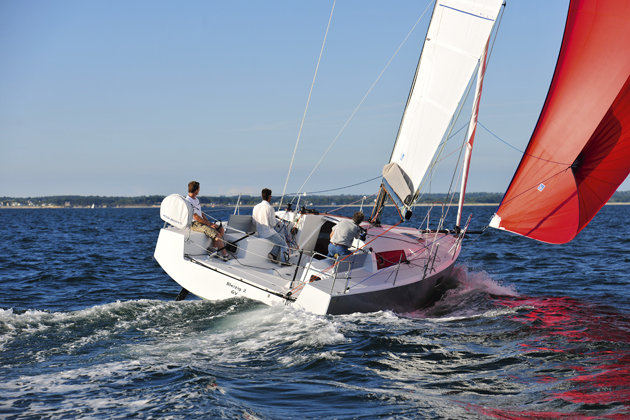Is the Pogo 30 the most fun you can have in a cruising 30-footer? Very probably, says Toby Hodges after an exhilarating romp off Brittany, so long as creature comforts are not uppermost in your priorities
Pogo 30 on test – pocket performer with cruising aspirations
And the Pogo 30 is marketed as a cruiser. Although her builders may be better known for their short-handed racing boats, the 30 is intended for the cruising market. Pogo’s expertise in lightweight builds has been applied here to inject some sparkling, yet manageable performance into coastal or offshore cruising. Yet the 30’s shape and beam creates remarkable volume below.
That said, she is a cruising yacht with a comparatively Spartan interior – Pogo puts most of its effort and expense into creating entirely resin-infused, unsinkable structures rather than creature comforts.
That’s the theory anyway. To put it to the test we travelled to Brittany.
Company builds out and out racers
Pogos are manufactured at a yard near Benodet called Pogo Structures. The word ‘Structures’ is the clue that Pogos are not the jolly children’s toys the name suggests. The company builds out-and-out offshore racers; some 90 per cent of the production Mini Transat boats, plus a healthy quota of Class 40s, are constructed here.
Given the breezy conditions we had when I arrived, I was a little aggrieved not to be able to go sailing straight away. Instead, sales manager Charly Fernbach insisted we visit the yard first so that I could understand the 30’s DNA.
It was a shrewd tactic. Seeing how the Pogo was built to tackle harsh offshore conditions boosted my confidence in its ability. It also helped explain why Pogos are so time-consuming to build – and why they have such a loyal fanbase.
The skimming stone
My infatuation with the Pogo 30 began within minutes of taking the helm. Despite the (now) light forecast and flat water, once out of the Odet River a 15-knot gust caught our sails and something remarkable happened: we started planing. We were close-reaching with white sails only – surely this was not possible?
Apparently it was – the wake separated cleanly from the transom as the boat lifted onto the surface. And as soon as the asymmetric popped open, we started planing almost non-stop. What a sensation!
It’s not so much the speed that creates the thrill – after all, she’s a small boat in a light breeze, so we’re talking single figures on the clock here. Rather, as owner Jean-Reno (JR) Riou points out, it is the sound – or lack of it.
While on the plane on a 30, everything goes delightfully quiet. It’s so relaxing. We spent most of our two days sailing in relative silence. The two crewmembers hardly had to do anything – the kite sheet was made off at the winch and I was simply helming to the luff.
“When we hit eight knots, the wake separates,” JR told me. “At 11 knots you get a whistle from the rudders and at 15 you hear the keel too.” Now that is something I would like to hear one day.
It says all you need to know about the 30’s performance that JR’s son, Yann, a member of the victorious Groupama Volvo team, showed little interest in sailing with his father until the arrival of the Pogo.
We pointed high with the kite (90–100° true) to maximise sea room, averaging eight to ten knots. But when we had to get back upwind, the experience remained distinctly pleasurable. With the maximum beam so far aft, I didn’t expect her to point, yet we averaged six knots and tacked in under 90°.
It was comfortable perched to weather. The large, moulded foot chocks provide reassuring grip. One of the only negatives I found was that there was little, if any, feedback from the twin rudders. That’s ideal if you want to reduce the power drain of the autopilot, less so for helming by hand. Pogo says it is addressing the issue.





